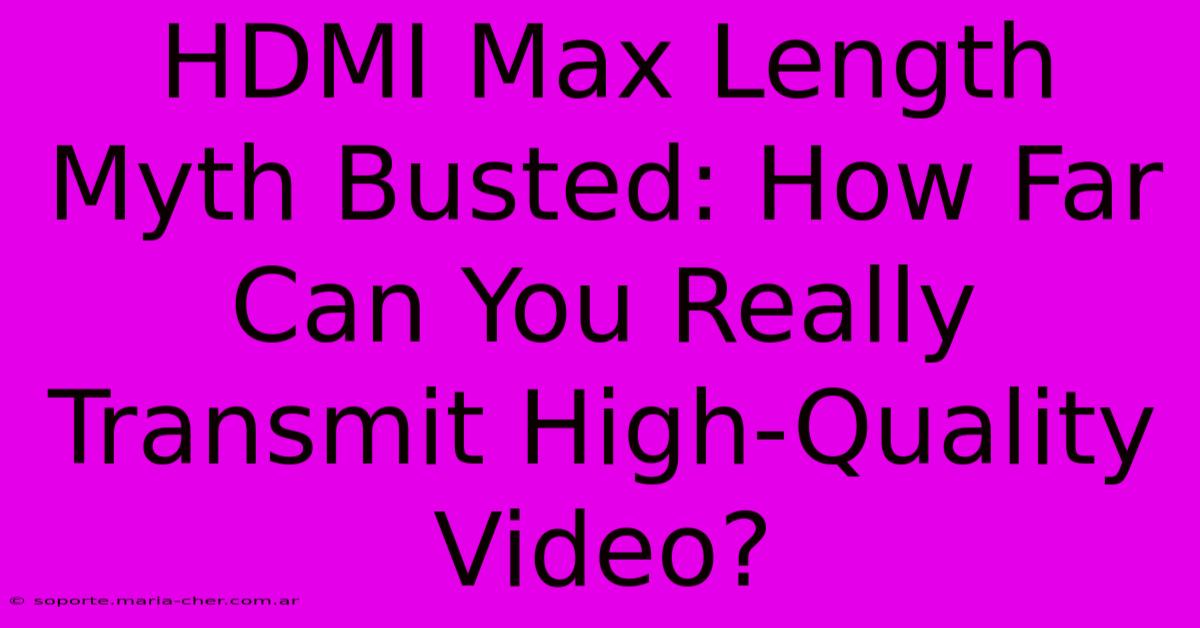HDMI Max Length Myth Busted: How Far Can You Really Transmit High-Quality Video?

Table of Contents
HDMI Max Length Myth Busted: How Far Can You Really Transmit High-Quality Video?
The age-old question for home theater enthusiasts and AV professionals alike: What's the maximum HDMI cable length for optimal performance? You've likely heard the "50-foot limit" whispered around forums and discussed amongst tech-savvy friends. But the truth is, the maximum HDMI cable length isn't a hard and fast rule. It's far more nuanced than a simple number. This article will bust the myths surrounding HDMI distance limitations and show you how to achieve crystal-clear video, regardless of the distance.
Understanding HDMI Signal Degradation
The real enemy isn't distance itself, but signal degradation. High-definition video signals, especially those carrying high resolutions like 4K and 8K, are complex and sensitive. As the signal travels along the cable, it loses strength and can become corrupted, leading to:
- Pixelation: A grainy, blurry image.
- Flickering: Intermittent loss of image.
- Color distortion: Unnatural or faded colors.
- No signal: A complete loss of video output.
These issues are more likely to occur with longer cable runs because the signal has to travel further, increasing the chance of attenuation (signal loss). The cable's quality, the HDMI version, and the bandwidth of the signal all play significant roles.
Cable Quality Matters: Don't Skimp on Materials!
Cheap HDMI cables use inferior materials and construction methods, making them more prone to signal loss. High-quality HDMI cables employ better conductors, shielding, and connectors, significantly reducing signal degradation. Look for cables that explicitly state their support for the resolution and bandwidth you need (e.g., 4K@60Hz, 8K@60Hz). Features like gold-plated connectors improve conductivity.
Extending HDMI's Reach: Practical Solutions
So, you need to transmit a high-quality video signal over a long distance? Here's how you can do it:
1. Active HDMI Extenders: The Reliable Solution
For distances exceeding the practical limit of standard HDMI cables (generally around 50 feet for 1080p and significantly less for higher resolutions), active HDMI extenders are your best bet. These devices amplify and re-transmit the signal, overcoming signal attenuation. They come in various forms, including:
- Fiber optic extenders: These utilize fiber optic cables to transmit signals over much longer distances with minimal signal loss. They're excellent for ultra-long runs of hundreds of feet.
- Cat5e/Cat6 extenders: These use existing network cabling (Cat5e or Cat6) to transmit the HDMI signal. They are cost-effective and can be a good alternative for moderate distances.
Choosing the right extender: Pay close attention to the supported resolutions, bandwidth, and maximum distance. Ensure it's compatible with your HDMI version.
2. HDMI Over IP Systems: For Maximum Flexibility
For the ultimate in flexibility and long-distance transmission, HDMI over IP systems are unmatched. These systems encode the HDMI signal into an IP stream and transmit it over a network, allowing transmission across vast distances and even over networks. They offer superior flexibility, allowing you to distribute signals to multiple displays.
Key Considerations for HDMI Over IP: Network bandwidth requirements should be carefully considered to ensure smooth, lag-free transmission.
3. Choosing the Right HDMI Cable: A Foundation for Success
Even for shorter runs, selecting a high-quality HDMI cable is crucial. Don't just buy the cheapest option. Investing in a quality cable, particularly one specified for the resolution and bandwidth you need, will ensure optimal performance and reduce the risk of signal issues.
Debunking the 50-Foot Myth: Conclusion
The myth of a rigid 50-foot HDMI limit is just that – a myth. While standard passive HDMI cables have limitations, there are many effective methods to transmit high-quality video over significantly longer distances. By understanding signal degradation and choosing the appropriate tools – active extenders or HDMI over IP solutions – you can overcome these limitations and enjoy stunning visuals, no matter the distance. Remember to always consider the specific requirements of your setup: resolution, bandwidth, and desired distance when choosing your solution.

Thank you for visiting our website wich cover about HDMI Max Length Myth Busted: How Far Can You Really Transmit High-Quality Video?. We hope the information provided has been useful to you. Feel free to contact us if you have any questions or need further assistance. See you next time and dont miss to bookmark.
Featured Posts
-
The Gilded Truth Unraveling Gold Filled And Gold Plated Jewelry
Feb 06, 2025
-
Devoilez Les Secrets Caches De La Typographie Sur Mesure Un Guide Etonnant
Feb 06, 2025
-
Unlock The Key To Unforgettable Learning Design Your Perfect Custom Flash Cards
Feb 06, 2025
-
88 Year Old Aga Khan Architecture Champion Passes
Feb 06, 2025
-
Unlock The Secrets Of The Enchanting Singke White Gerbera Daisy
Feb 06, 2025
